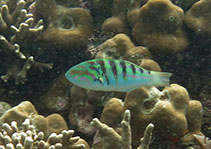
|
Thalassoma hardwicke (Bennett, 1830) Sixbar wrasse |
||
| Lulukdayan, Mameng, Sixbar wrasse, Bagondon, Bagundun, Balaki, Bankilan, Banog, Bugay-bugay, Bunak, Bungat, Buntugon, Danlugan, Isdang bato, Labayan, Lampalampa, Lubay-Labayan, Lubay-lubay, Lubay-lubayan, Lubayan, Maringyan, Molmol, Pilo-pilo, Pirat-pirat, Tamago, Tausay, Verde verde | ||

|
|
photo by
Du, J.-G. |
| Family: | Labridae (Wrasses), subfamily: Corinae | |||
| Max. size: | 25 cm TL (male/unsexed) | |||
| Environment: | reef-associated; marine; depth range 0 - 15 m, non-migratory | |||
| Distribution: | Indo-Pacific: East Africa to the Line and Tuamoto islands, north to southern Japan, south to the Lord Howe and Austral islands. | |||
| Diagnosis: | Dorsal spines (total): 8-8; Dorsal soft rays (total): 12-14; Anal spines: 3-3; Anal soft rays: 11-11. Color pattern remains similar with growth with terminal males becoming gaudier than primary males (Ref. 37816). Pale green with 6 dark bars, last two as saddles over the tail. Head with pink bands radiating from eye in large adults (Ref. 48636). | |||
| Biology: | Occurs in shallow lagoon and seaward reefs, slopes and along drop-offs to moderate depths. Occurs in small, loose groups (Ref. 48636). Feeds on benthic and planktonic crustaceans, small fishes, and foraminiferans. | |||
| IUCN Red List Status: | Least Concern (LC); Date assessed: 12 June 2008 Ref. (130435) | |||
| Threat to humans: | harmless | |||
| Country info: | Known from Prieto Diaz, Sorsogon, Surigao City (Ref. 58652), Nasugbu, Batangas (Ref. 107854), Calatagan, Batangas (Ref. 107852), Tañon Strait (107276), Lanuza Bay (Ref. 104756), Bongo Island and Paril-Sangay Protected Seascape, Moro Gulf, Davao Gulf, Sarangani Bay, and Malalag Bay (Ref. 106380), and Bantayan Is. in northern Cebu (Ref. 114734). Also Ref. 1602, 48613, 53416, 121724. | |||